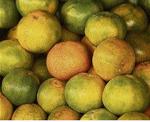
Heather Little-White, PhD, Contributor
You see them everywhere - in the markets, along the wayside in stalls, supermarket shelves are laden with bright-yellow skinned oranges from a bumper season this year.
Oranges belong to the citrus family which includes other fruit such as lemons, grapefruit, tangerines, mandarins and kumquats. They are popular both for eating and as an ingredient in recipes, with all parts of the fruit being used in various ways.
There are two main types of oranges, the sweet and bitter. The sweet orange, Citrus sinensis, is more familiar to our culture and is believed to have originated in South East Asia. The spread of the sweet orange to Europe via North Africa was relatively slow. However, traders brought oranges to the Middle Ages where they were widely distributed and eaten throughout much of the western and southern regions.
Scurvy
Portuguese, Spanish, Arab and Dutch sailors are known to have planted citrus trees along trade routes to prevent scurvy. Columbus was the first person to take orange seeds to the New World in 1493 and established plantings in Hispaniola. The first plants of sweet orange in the United States were in Florida.
Sweet oranges are categorised into four groups - round, navel, blood and acid-less orange. The most common variety is the round, readily available in supermarkets and greengrocers. Navel oranges are so named because of the small secondary fruit embedded at the bottom of the fruit and which resembles a navel (belly button). Blood oranges are so-called because of red colouring in the flesh, the intensity of which varies from a few streaks to almost complete red. Acid-less oranges are characterised by a sweet, but bland flavour.
High-fibre
Oranges are low in calories and are free from cholesterol and sodium and have just a trace of fat. The high-fibre content of oranges helps keep down cholesterol levels. Oranges are also a good source of calcium. Oranges easily fit the recommendation for eating at least five servings of fruit and vegetables each day. One orange easily provides more the Recommended Daily Allowance (RDA) for vitamin C.
Signs of Vitamin C Deficiency
Deficiency in vitamin C results in a condition of inflamed and bleeding gums called scurvy. There are clear telltale signs for a deficiency in vitamin C:
Scaly, rough and dry skin Difficulty in wound healing Excessively dry hair with split ends Frequent infections Frequent nosebleeds Anaemia Pain and swelling in joints Weakened tooth enamel.Oranges can be as a part of any meal. Studies show that people who eat fruit such as lemons, tangerines, oranges and other whole foods tend to eat less at subsequent meals, compared to people who eat more calorie-dense foods such as chips, snack crackers, desserts or candy.
Culinary preparations
Did you know that when you eat oranges with your meal, the body's absorption of iron from plant foods is boosted by 400 per cent? Oranges are used in many ways in culinary preparation with the most popular being orange juice. Freshly squeezed orange juice provides a whopping dose of vitamin C and an abundance of folate. Orange juice also offers good amounts of other B vitamins plus magnesium which promote healthy skin, nerves and muscles. The pulp from unstrained freshly squeezed orange juice provides some fibre which helps with cholesterol control. One orange yields a half a cup of juice.
The uses of oranges or the juice in culinary preparation are endless. With a zesting tool, you can grate orange rind to use in recipes, rice or stir fry for added flavour. Orange juice drizzled over fresh fruit prevents then from becoming brown due to oxidation. Orange sauces are common accompaniments to meats. A couple of tablespoons of orange juice can be added to a fruit cup for a great flavourful sauce. Orange wedges are eaten as a light snack and oranges are excellent for use as edible garnishes. Combine the juice with other fruits and yoghurt in the blender for a smoothie any time of day.
Orange Ambrosia
Breakfast may include Orange Pancakes with Orange Butter Sauce and lunch may have delightful treats like Orange Grilled Salmon and dinner's main course may be Roasted Cornish Hen with Wild Rice and Orange. Desserts include Orange Ambrosia, Orange Nut Bread, Orange Pound Cake or Orange Pie.
Oranges are very useful outside of culinary preparations. They are used for repelling flies, as substitutes for washing clothes and shampooing hair, cleaning marble surfaces, refreshing garbage disposals, deodorising rooms and closets, shining furniture and glass, removing stains from walls and sauce pans and as a hairspray.
Headaches
Despite the abundance and versatility of the product, some persons get headaches from eating oranges and others are allergic to the rind which causes contact dermatitis oranges. Persons have complained of having intestinal gas after eating oranges.
Oranges are an age-hold staple that is chock-full of nutritive value and provides versatility in food preparation. Enjoy them when you can!
Heather Little-White, PhD, is a nutrition and lifestyle consultant in Kingston. Send comments to editor@gleanerjm.com or fax 922-6223.

